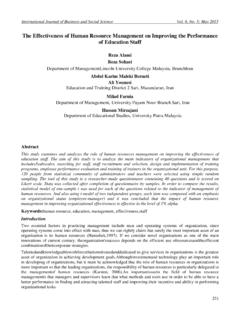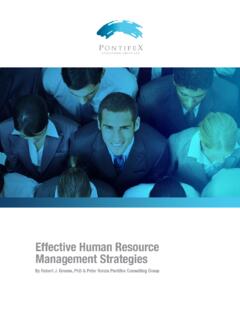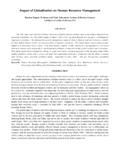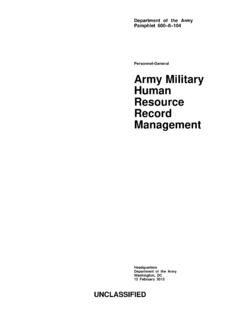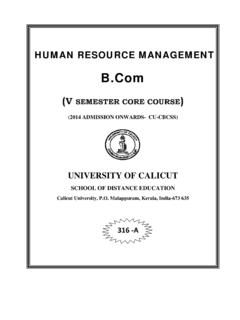Transcription of The Risk Management Framework to Strategic Human …
1 International Research Journal of Finance and Economics ISSN 1450-2887 Issue 36 (2010) EuroJournals Publishing, Inc. 2010 The Risk Management Framework to Strategic Human resource Management Triant Flouris Dean, School of Aviation Sciences; Professor, Aviation Management School of Aviation Sciences Daniel Webster College, Nashua, NH 03063-1300, USA E-mail: Ayse Kucuk Yilmaz Corresponding Author Assistant Professor Department of Civil Aviation Management School of Civil Aviation, Anadolu University, 26470 Eskisehir, Turkey E-mail: Abstract This study deals with complexity of Human factors and provides insights to managing Human factor based risks.
2 The offered risk Management Framework to Strategic Human resource Management provides an integrated and proactive approach for tackling important Human factor risk considering Human factors with its two interconnected roles. Source and manager interface are critical points to achieving business objectives in financial, Strategic and operational context. The offered Framework model allows an effective Framework for applying the combination of the Human resource and risk Management principles for managers.
3 The model uses a system approach to manage Human performance and capability limitations. In this article, the proposed full-set RSFs/RIFs taxonomy and new score formula are weighted with Analytic Network Process Method in the context of new model. Keywords: Human Factor, Human resource Management , risk Management , risk analyze, risk score, strategy. JEL Classification Codes: M100, M120, M190 1. Introduction Risk Management to Human factor is the process of identifying and assessing Human factor based risk and then developing strategies to Strategic Human resource Management .
4 It is also the holistic, proactive and systematic consideration of Human capabilities and limitations. The effective Management of Human resource based risks is a cornerstone factor of corporate success. Instead of decreasing the importance of Human being, technological development has contributed the opposite. Technology, in the absence of Human resources is not yet self-sufficient. Human factors are still essential in most functions and activities performed by businesses where either intense or moderate technologies are used.
5 Managing Human factors based risks requires both more systematic decision International Research Journal of Finance and Economics - Issue 36 (2010) 26 frameworks and new assessment tools such as risk shaping factors and risk score. Offered model in this study includes these emerging requirements to holistic and Strategic risk Management of Human factor. Although most of current research fully assumes corporate risks, it cannot be said that the Human risk Management concept is treated sufficiently. Business leaders recognize the link between business performance (financial and operational performance) and the personnel within their organization.
6 Moreover, they understand that personnel-related issues need to be at the heart of the boardroom agenda. Managers are being encouraged to implement Human factor s risk Management strategies that support the organization s business objectives and increase accountability and transparency around Human factor Management and reporting. The bottom-line: Human Factor based risks are increasingly seen as a Strategic linchpin one that needs to work closely with operations, finance, and other corporate departments to help drive business strategy and success (PricewaterhouseCoopers, 2008).
7 New Human Factor Risk Management (HFRM) model is structured by managing activities of Human based risks for businesses and provides a comprehensive and coherent Framework for the evolution and Management of Human factors. The Human Factor Risk Management (HFRM) model continues to anticipate potential Human factor based risks and develops appropriate responses for various scenarios. New Human Factor Risk Management (HFRM) model can help provide a more precise understanding of risk factors associated with the Human element and to furnish insights on their appropriate identification and prioritization via scoring and Management .
8 This study reviews both leading enterprise risk Management (ERM) guidelines and Strategic Human resource Management (SHRM) literature in the development process of the Human Factor Risk Management (HFRM) model. These are reviewed in view of their context of Human factor based risks. In the Enterprise Risk Management field leading guidelines are reviewed in terms of Human factor based context such as Enterprise Risk Management Integrated Framework and Application (The Commission of Sponsoring Organizations of the Treadway Commission, 2004); Overview of Enterprise Risk Management (Casualty Actuarial Society Enterprise Risk Management Committee, 2003).
9 Enterprise Risk Management Specialty Guide (Society of Actuaries, 2006), Risk Management Australian/New Zealand Standard AS/NZS 4360:1999 (Standards Australia/Standards New Zealand, 1999); Risk Management Standard (FERMA, 2003); Risk Management Standard (The Institute of Risk Management ; Association of Insurance and Risk Managers and ALARM, 2002); Understanding ERM-An Emerging Model for Building Shareholder Value (KPMG, 2000); Basic Frameworks for Risk Management (NERAM, 2003); Enterprise Risk Management - A Analytic Approach (Tillinghast-Towers Perrin, 2000); Risk Management : Guideline for Decision-Makers (CAN/CSA-Q850-97) (Canadian Standards Association,1997).
10 The Strategic Human resource Management (SHRM) literature is rooted in manpower planning, but it was the work of influential Management gurus ( Ouchi, 1981; Peters & Waterman, 1982), affirming the importance of the effective Management of people as a source of competitive advantage, that encouraged academics to develop frameworks emphasizing the Strategic role of the HR function ( Beer et al., 1985; Fombrun et al., 1984) and attaching the prefix Strategic to the term Human resource Management (Bratton, 2001).
